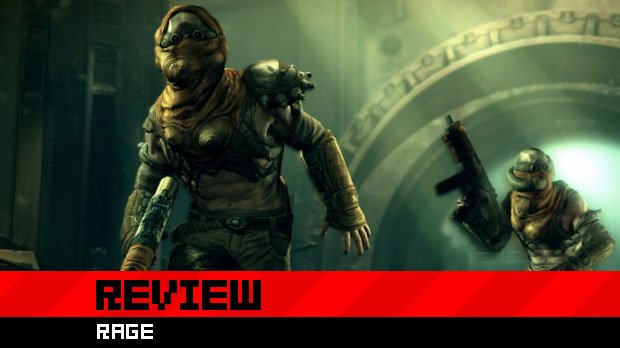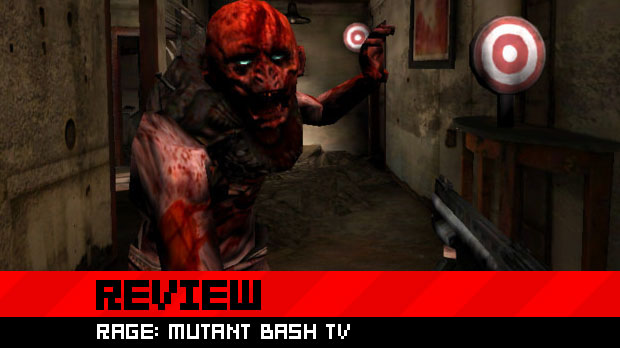It’s been quite some time since id Software released a brand-new hatchling into the world. DOOM and Quake have kept it relevant through the years, but there’s a new four-letter name on the cards, and that name is RAGE.
It’s been four years since RAGE first reared its head as an id Tech 5 tech demo, and expectations for the game have most certainly been high. In advertisements, id has not been shy about reminding us of its first-person shooter heritage, but this is not the ’90s anymore, and competition has never been fiercer.
RAGE has a lot to live up to, and many promises to deliver.

RAGE (PC, PlayStation 3, Xbox 360 [reviewed])
Developer: id Software
Publisher: Bethesda Softworks
Released: October 4, 2011
MSRP: $59.99
It would be very difficult to discuss RAGE without mentioning both Fallout and Borderlands — comparisons that are easily justifiable since id Software has merrily stolen from both. Set in a post-apocalyptic world where cryogenically frozen people emerge from “Arks” to find a wasteland ruled by bandits and mutants, everything about RAGE feels familiar.
Borderlands‘ visual style — including bold, cartoon-esque outlines — and Fallout‘s general premise are blended with a BioShock-inspired loot system to create a game that looks and feels like something we’ve seen a bit too much of in recent years. The game looks dated, which is strange, considering it is one of the most graphically gorgeous games on the market.
While its art style feels passé, the technology bringing it to life definitely does not. Of particular note are the animations, which are easily the most lively I’ve seen. Enemies movements’ are especially stunning, and I was most impressed by just how varied their behavior can be. Even the simple mutant has a wide range of actions — they’ll roll to avoid fire, grab onto the ceiling, hold themselves elevated in doorways like spiders, and leap to close large distances. Different tribes of bandits have unique behaviors to boot, with Ghost clan members charging wildly and running along walls, or the more pragmatic Shrouded retreating when taking heavy fire and covering each others’ escape.

RAGE splits itself into first-person combat and third-person vehicular sections. Taking a rather formulaic structure, general progress consists of heading into town, taking on a mission, driving to a “dungeon” area and killing a lot of things. This pattern repeats itself from beginning to end, in a world that looks quite open but tends to be shockingly small and restricted. There are huge chasms, open mountains and wide fields, but the they are inaccessible and exist only as window dressing. There’s a linearity to the game that seems at odds with the world’s open appearance. This is a problem that’s only compounded when you realize how devoid of exploration that world truly is — there is one small city area for each half of the game, and the dungeon locations sit at the ends of a meager selection of straightforward paths. One wonders why the illusion of an open world was put in place — I’m all for linear experiences, but not when they’re pretending to be something they’re not, and offering the vision of something far larger than it is.
Getting from A to B is a pleasant affair, as vehicles are easy to handle with tight, precise controls. Players can take part in races within each city, earning tokens that can be spent on upgrades such as increased boost power and extra weaponry. These upgrades will be essential as the Wasteland becomes increasingly populated with enemy vehicles that spew bullets and rockets with deadly precision. Collecting and upgrading vehicles is a cool part of RAGE, but the overall selection of machines and corresponding enhancements isn’t quite deep enough to remain compelling for long.
The combat sections will feel a bit more familiar to id fans, especially those who enjoyed the atmospheric DOOM 3. Like the horror-shooter sequel, RAGE‘s combat is all about setting up a series of corridors, broken up by rooms full of enemies. Opponents are remarkably aggressive, and rather difficult to hit thanks to their love of rushing, ducking, weaving and taking cover (not to mention the fact that aim assist is either terrible or non-existent on consoles.) There’s a nice variety of weapons, ranging from the humble pistol and assault rifle to more delicious arms, such as a crossbow that can fire mind-controlling darts. Each weapon has multiple ammo types, and can extra attachments can be purchased at stores in town. If you die, you have the ability to get back up by taking part in a small QTE-like minigame. However, this “defib” option needs to recharge, so players can’t just resurrect indefinitely.

Aside from the fact that erratic enemies are frustratingly difficult to hit, RAGE brings the action in a big way. Combat sequences are fast-paced and intense with enemies that range from savagely aggressive to prudently tactical. As the game progresses, more vicious factions are encountered, each with their own unique weapons, strategies and environments, from the feral Jackal clan to the high-tech, militant Authority. There’s a real sense of life in each fight, with opponents communicating to each other about their battle status and commenting on the player’s movements. Sometimes the smoke and mirrors of this combat dialog is exposed when enemies that can’t see you are still telling their friends what you’ve done, but the illusion of smart, observant opposition is generally maintained to an effective degree.
Helping out in combat is a range of gadgets that can be built using debris from the environment and corresponding schematics. These range from the invaluable Wingstick — a deadly bladed boomerang — to remote-controlled bomb cars, sentry turrets, and spider-like robots that act as autonomous allies. Due to the huge, cluttered menu system, it can be difficult to find or even remember the gadgets on offer, but they’re all incredibly useful once you recall they exist.
Speaking of the menu system, it could definitely have used some work. Unnecessary visual effects upon switching tabs makes menu navigation feel laggy and inconvenient, and items are thrown together with monochrome images representing each one. With only four weapons and four gadgets able to be stored in a quick-select slot, the menu is needed often, and it’s a pain to use.

RAGE throws a few extra distractions into the mix, just to spice things up. As noted, each city has a collection of vehicle races, and there’s also a job board with intermittent sub-quests. There are also minigames, such as a board game in which you “roll” dice to shoot mutants before they kill your avatar, a finger-puncturing knife trick challenge, and a battling card game called RAGE Frenzy. The card game is my personal favorite, using collector cards found in the game world to battle AI opponents in a simple but satisfying game of chance. I’d have loved for RAGE Frenzy to be expanded, as the random element of collecting has been killed off in favor of predetermined cards hidden in predetermined locations, and there are only two people in the entire game who play.
The problem with RAGE Frenzy, however, is the ultimate problem of RAGE as a whole — it’s full of great ideas and it’s truly fun to play, but every single idea fails to reach its potential. It would be unfair to call such a polished and enjoyable game unfinished, but the fact that every included element needed further expansion at least suggests an experience that must be deemed incomplete.
There are weapon upgrades, but only a mere handful of them. You can enhance your vehicles, but there’s a tiny range of auto parts on offer. You can equip new armor … only once during the whole game. There are gadgets to be built, but no depth to the crafting system. There’s the tease of an open world, but it’s not open at all. There are hints of role-playing elements, but no attainable new skills or statistics. There’s a collectible card game without the fun of collecting and only two people to play it with. There are shops, but you can buy all the new schematics and armor upgrades on your first visit and only need to return for ammo or crafting ingredients. There are cities but only two of them, featuring the same minigames, and they’re small. RAGE is a game that promises many things but delivers only a fraction of each. A vastly entertaining fraction, I have to add, but it leaves one aching for more, and imagining what could have been if the experience weren’t cut so coldly short.

This is a feeling carried through into the multiplayer, which is amusing but shallow. RAGE‘s competitive online mode is cribbed from the various vehicular combat sections in the campaign, and feels like a mixture of Twisted Metal and Mario Kart. However, each game can only contain four players on maps that are far too large for such a small number. As a result, matches feel constrained and often consist of three players shooting the rear of whoever is in front, then another swapping its place. At the time of writing, matchmaking doesn’t seem to work, either. Bethesda had scheduled matches for reviewers, but nobody was able to find them. There are multiple reviewers still trying to get into a game, but RAGE so far doesn’t even attempt to find lobbies, forcing each player to start their own instead. I eventually got to try it by starting a private match and inviting someone else in.
There’s a co-op mode that revisits locations from the campaign and gives two players a series of objectives to complete against quite challenging odds. These “Legend” stages have a scoring system in place for some passive competition, and attempt to breathe extra life into RAGE‘s narrative by theming every stage around a backstory. Ultimately, however, these short little levels feel shallow and the scoring system encourages a more frantic style of play that contradicts the need for players to take their time and work together. All told, the multiplayer simply isn’t worth putting that third 360 disc into the machine, and it would have been far better for id Software to remove it completely and work on a fully-fleshed-out solo mode.

For the ten or so hours that it lasts, RAGE has a lot of honest, straightforward, amusing action on offer. However, one can’t help but feel that this is little more than a prologue, something id Software put together in order to show the potential of a franchise, rather than realize the potential of a game. As you rush around the world and get brief introductions with major characters, it seems like you’re on a quick sightseeing tour of RAGE’s universe rather than setting up camp for an extended stay. Everything RAGE does, it does well, but it just doesn’t do anything to a conclusive degree. This is hammered home by the rushed ending with an absolutely classless cliffhanger.
RAGE is fast food, the kind of fast food that looks much more satisfying on the menu than it does once served. It’s tasty, for sure, but you’ll be starving almost as soon as you’ve finished. By no means is RAGE not worth your time — it looks stunning, the combat on both wheels and foot is fun, and there’s a tremendous sense of atmosphere that deserves to be experienced. However, RAGE‘s quality only makes its lack of ambition more painful in the long run, as it could easily have been better than it is. It’s a good game, most definitely, and one that id fans will enjoy … just don’t expect it to do half of what it looks like it can do.






